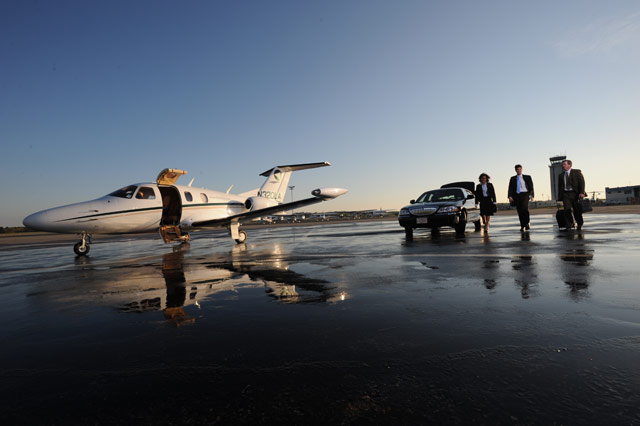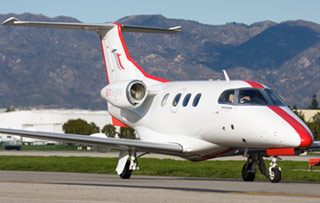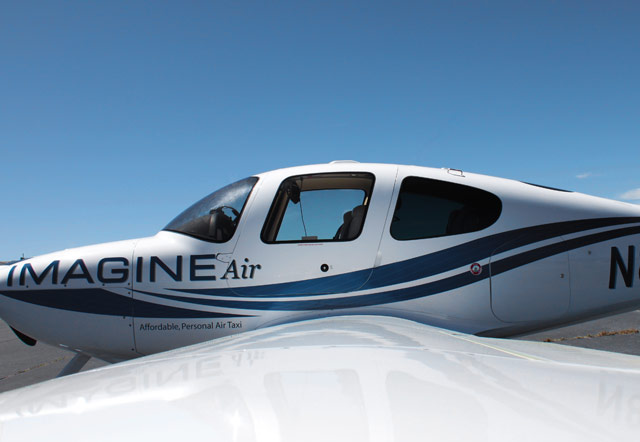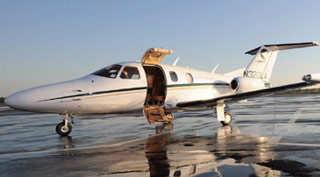The death of the air taxi model has been greatly exaggerated - in the USA at least. This niche but gritty industry has faced its challenges since the first tranche of operators opened their doors about eight years ago - not least, the high-profile collapse in 2008 of one of the early adopters, DayJet.
The sensational downfall of the Florida-based start-up led to speculation that the entire industry would be brought to its knees. Not surprising, perhaps, given the huge expectation hanging over the future success of this Eclipse 500 very-light jet operator.
 |
| The original Eclipse 500 is at the heart of efforts to deliver region on-demand private aviation |
"DayJet was a great idea at the wrong time," says Joe Leader, president of the industry trade body the air taxi association. "The best way to ramp up an air taxi operation is to grow the company slowly," he adds. "But their operation of per-seat-on-demand only works if you have a scale and have a high number of passengers. Otherwise, it's just air taxi fleet filled with many empty legs," he adds.
Investors withdrew promised capital leaving DayJet unable to scale its efforts. The company then collapsed.
Investor reluctance was fuelled by the financial crisis that struck with a vengeance in late 2008. "The consequence at that time and thereafter is that it has been very difficult to fund large-scale air taxi operations," says Leader.
His views are borne out by the failure of two more high-profile air taxi companies. Pogo - founded in 2004 by long-time American Airlines chief Robert Crandall and Don Burr, creator of People Express - was unable to raise capital to fund its ambitious programme in 2005. Six years later, SatsAir - arguably the most successful single-engined aircraft air taxi company in the USA at that time with a fleet of 26 Cirrus SR22s - was forced to shut its doors because of plummeting revenues and insufficient funds.
AIR TAXI AMBITIONS
The downfall of these prominent players has strengthened the resolve of the air taxi visionaries, who are still determined to make regional on-demand private aviation available to millions of ordinary business executives and middle-class leisure travellers across the USA.
"There are around two dozen companies in the USA that could be defined as air taxi operators," says Leader. This is defined as offering a fleet of more than five low-cost, new-generation aircraft at a price point broadly in line with an airline's club-class fare of about $1,500 per flight. To do this, the aircraft must be flying for as many hours as possible each day with revenue-making passengers.
It is also important to build critical mass across key locations to reduce the burden of empty legs, Leader adds.
This may be a tall order for many operators in this economic climate, but not for three-year old JetSuite. "We plan to be the biggest brand [in private jet operations] within ten years," says Alex Wilcox, chief executive of the Orange County, California-based air taxi company
Wilcox's optimism and ambition is justified. Since operations began in 2009, the Embraer Phenom 100 operator has seen month-on-month revenues climb by about 8%.
 |
Jetsuite JetSuite aims to be the “biggest brand” in private jet operations within 10 years |
"We own and operate 13 Phenoms today and plan to increase this tally to 50 jets within five years," Wilcox says. "So far we have flown 22,000h and the customers just keep coming."
He attributes this growth to the quality of service, and brand exposure: "The recession has taught us to be smart. We have grown slowly and carefully and are using the right tools for the job."
This means sticking to a fleet of identical aircraft with a good range and fuel economy. This helps to drive down the cost of operations, Wilcox argues, "after all, fuel is the industry's number one expense".
He believes air taxi companies have to offer an appealing product if they want to lure passengers away from the airlines and into private jets.
To achieve his goal, Wilcox says, "you have to create awareness of the brand". Jet Suite has put this strategy to good use through its canny employment of social media. The company has built an enviable following on Facebook and Twitter through which it touts its headline-grabbing, last-minute "Suitedeals" on the Phenom.
Fares as low as $499 one-way from Los Angeles to Las Vegas or Washington to Boston are regularly touted. This whole aircraft price - valid as long as the customer registered through Facebook - compares with about $2,500 to $8,000 per hour charges for traditional charter.
On Thanksgiving last year, Jet Suite advertised a jaw-dropping $1 flight, says Leader, a marketing effort that was hugely successful. "Not only did they gain thousands of new fans on Twitter and Facebook overnight, but they boosted brand awareness for JetSuite and the air taxi market as a whole," he adds.
By the end of 2011, JetSuite's annual flight tally rose by 50% to 10,000, compared with the previous year. Passenger traffic soared by 60% during the same period.
To boost its exposure to airline passengers, JetSuite teamed with Singapore Airlines to provide onward travel for the Asian carrier's passengers to and from a host of US gateways, including New York JFK, Los Angeles and San Francisco.
JetSuite connects "Singapore Suites" customers to hundreds of general aviation airports or to those with regularly scheduled commercial services, Wilcox says. "We can reach most of those places, non-stop. That's literally hundreds of airports, whether or not they have commercial airline service."
AIRPORT ACCESS
The ability of typical air taxi aircraft to fly into the USA's huge airport network is a major advantage for the operators, Leader believes: "Air taxis are a democratisation of air travel." While only 330 cities are served by the commercial airlines, there are 10,000 airports in the USA which small aircraft can access. "They link communities with the rest of the country," Leader says.
This view is echoed by Richard Humphrey, co-founder and chief executive of Danbury Connecticut-based operator Kavoo, which operates in northeast USA and Canada. "Air taxis solve a regional need," he says. "In the northeast alone there are 50 commercial airports and 1,000 private airports/airfields close to local communities. People will always need to commute so we have to offer them a cost-efficient and flexible alternative to the car and airline travel."
Kavoo is one of a growing number of air taxi companies which has adopted the piston-engined Cirrus SR22 as the lynchpin of its programme. "The missing piece in any operation is fuel economics," Humphrey argues.
For about $500 per hour, Kavoo will take three passengers to a range of destinations within its service area. "For most hops under 500 miles you are going to be within the range of a last-minute commercial airline ticket - and certainly under the price of a first-class fare," says Humphrey.
The aircraft has been so successful on routes of 200 miles or less, Kavoo is looking to expand its route network in the next 12 months and increase its fleet from six to ten aircraft "so we can reach critical mass", says Humphrey who, along with partner Curtis Brunjes, have invested more than $1 million in the operation.
Kavoo has been "operating on a skeleton crew" since its launch three years ago. "From the start it has been our aim to grow the business slowly and prudently. We want prove the business model before we approach [investors] to fund our expansion. I think we have done that," Humphrey says.
Kavoo has witnessed a "notable increase in demand" during the past year. "We are getting out there and connecting with travellers," he adds. "They, in turn, are saying 'Oh my gosh, I never knew this type of service existed.'"
SERIOUS CIRRUS
ImagineAir has also seen the market for its SR22 escalate year on year since operations began five years ago.
"SatsAir's collapse was a big boost to us initially as many of their customers within our operations footprint [southeast USA] crossed over to ImagineAir," says Haroon Qureshi, ImagineAir director of sales and marketing.
 |
ImagineAir ImagineAir has seen the market for its SR22 escalate year on year |
The Lawrenceville, Georgia-based company began services with two of the piston singles. "Our initial plan was to launch with Eclipse 500s but we changed to the SR22 because of certification delays," Qureshi says.
He suggests, that while some travellers do not want to travel in a small, single-engined aircraft, the response to the SR22 has been overwhelming. "Traditionally, private aviation has been dominated by the big aircraft [such as Gulfstream, Hawker types] which put it out of the reach of so many travellers, he says. "The SR22 has brought down the cost of private travel and in doing so has lowered the cost of entry for many people."
ImagineAir has taken a lean, conservative approach to its development. "We have expanded as and when the demand dictates. Consequently, we have experienced a growth year on year of 35% since 2007," says Qureshi. He suggests there was "too much hype" surrounding the air taxi market in the early days which was "impossible" to live up to. "People were saying the skies would be filled with air taxis. This isn't the case, but many companies still have ambitions to grow the market. This will be done slowly and carefully," he adds.
ImagineAir now has eight SR22s in its fleet and is set to widen its service area during the coming months to broaden its reach of Maryland and West Virginia. "We will also add another two SR22s to give us a faster response time," says Qureshi.
ImagineAir's "five-year goal" is to expand into Texas and California. "To give us the extra range, we may look at adding a Phenom 100 or Cessna Citation Mustang," he adds.
TECHNOLOGY BOOST
William Herp, air taxi industry veteran and chief executive of eight-year-old operator Linear Air, believes the future of the air taxi industry rests with high-quality, low-cost, low-acquisition aircraft, such as the SR22 and the original Eclipse 500.
"When it was launched, the Eclipse 500 was mooted as the perfect aircraft for the air taxi industry," he says. "Not only was it designed for high utilisation operations, but it was to be produced in high volumes and sold at around $1.5 million - vital components for any low-cost air taxi operation."
Concord, Massachusetts-based Linear Air is an Eclipse 500 customer with six of the early very-light jets on its aircraft operator's certificate and another nine "in our network". The company covers more than 750 cities in northeast USA, the mid-Atlantic and eastern Canada from bases in Boston and New York. It also covers destinations throughout the southeast, mid and southwest of the USA, as well as northern Mexico.
 |
| Lineair |
Herp admits that while the Eclipse 500 is an economical aircraft, it is not as competitive within the air taxi niche as the SR22. "Only around 30 of the 200 Eclipse's [in the USA] are being operated commercially, so the economies of scale are not yet there," he says.
"The Eclipse 500 could have to carry four passengers every time in order to operate competitively within this sphere. The Cirrus, however, only needs two passengers to be competitive as its costs are so much lower. That is why this aircraft has become so popular with commercial operators."
Herp was so persuaded by the SR22, Linear Air joined forces in July with three-year-old New York SR22 "air limo" company Hopscotch Air to cross-promote their services .
"We have clients who sometimes only require a short trip with one or two people. Hopscotch's clients sometimes need jet speed and range of around 750 miles," says Herp, "Now, with Hopscotch, we can offer the SR22 at attractive prices for trips of up to 300 miles non-stop."
In an effort to drive up demand and boost utilisation of its Eclipse fleet, Linear Air is investing heavily in its online quote and booking software. Earlier this year, it joined forces with internet travel search site Hipmunk to tout its departures across the northeast. "This has been very successful not only in giving exposure to the Linear Air brand but also by promoting the benefits of business aviation to travellers who perhaps wouldn't have considered using private aircraft before," says Herp.
While Hipmunk allows Linear Air to connect with travellers, Herp says "its next step is to interface with operators", paving the way for the company to expand its network. "We plan to roll out a technology platform [with Hopscotch] next year," he adds.
The air taxi model is "well and truly alive and kicking" Herp concedes. "We have weathered the storm and built strong foundations for the future," he adds.
Demand for air taxi services will rise, Herp believes, as US regional airlines continue to lower the "quality and quantity" of services to smaller markets.
"From flying into a headwind in the early days, the US air taxi market is now being propelled by a tailwind and is heading in an upward trajectory," he adds.
This may embolden OEMs to take a more aggressive approach in supporting high-volume fleet operations.
The next generation of single-engined jets such as the Cirrus SF50 could provide a huge boost for this industry with their speed, range and low price point. "However, as few details are known about the aircraft yet, we will have to wait and see," says Herp.
Source: Flight International



















